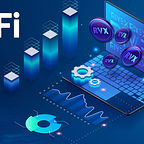The Rise of Blockchain Smartphones and Web 3.0
In the past decade, smartphones have become an integral part of our life. Considering the importance of smartphones in our daily life, it would be hard to imagine a world without them.
A big credit goes to Google (maker of Android) and Apple (maker of iOS) for development and innovation in the world of smartphones, resulting in mainstream adoption. When considering a future where blockchain technology will be an essential part of our life, smartphones can be a great tool to facilitate that. Therefore, before delving into the current development, limitation, and future prospects of blockchain smartphones, it is necessary to first understand the concept of blockchain smartphones and how are they different from regular smartphones.
What are blockchain smartphones?
The blockchain smartphones are basically regular smartphones with added functionality leveraging the blockchain technology. These added features include additional security, the capability to mine cryptocurrencies, built-in hardware wallet, direct dapp (decentralized app) interface leveraging Web 3.0. Although still in the early stage, dapps are basically mobile apps that run on a decentralized peer-to-peer network and are touted to revolutionize the mobile app ecosystem.
Understanding Web 3.0
Web 3.0 can be defined as the third generation of web application touted to revolutionize the internet as we know it. Looking at the past, the major paradigm shift of the internet can be summarized into the journey of first-generation static ready-only Web 1.0 to second-generation dynamic read-write Web 2.0.
Similarly, Web 3.0 is the next step towards the evolution of the internet by taking away the power of data from a handful of tech giants and giving it back to the people by opting for a decentralized peer-to-peer network. Comparing it to history of web, web3 can be touted as the generation of web with read + write + own capabilities.
Besides distributed computing or decentralized networks, Web 3.0 also incorporates semantic web, 3D graphic, artificial intelligence, and ubiquitous connectivity.
These key characters of Web 3.0 can be further explained as:
Semantic Web — The goal of the semantic web can be defined as making the internet more intelligent. It can be achieved by making internet data machine-readable, thus rather than just relying on keywords but making it possible for machines to read the whole content to improve web technologies.
3D Graphics — Web 3.0 will also shift the internet away from the conventional 2D web to more-realistic 3D graphics by incorporating the enhanced graphic processing capabilities of new-age processors. This will give a push to new innovations in the world of online gaming, virtual reality, or even ambitious projects such as digital avatars of all individuals using AI.
Artificial Intelligence — Even though some aspects of AI can already be seen with Web 2.0. However, Web 3.0 will extensively make use of AI capabilities to make a better prediction to avoid fraud and security flaws in the system. For example, blockchain networks can incorporate AI and different consensus algorithms to avoid a 51% attack.
Ubiquitous Connectivity — The word ubiquitous also means omnipresent i.e., being present everywhere at the same time. The rise of the 5G network will give the necessary push to third-generation by making it possible for everything around us to connect to the internet. Also known as Internet of Things (IoT).
Challenges of Web 3.0
Looking at the currently available infrastructure and technical limitations, the biggest challenge for Web 3.0 would be tackling a vast amount of data. As data has already surpassed oil as a most-sought-after commodity and most of it currently being owned by big tech companies with their private server farms.
Suffice to say, it will be challenging to take that power back. Besides the vastness of data, there also lies other challenges such as vagueness of data, inconsistencies, and the likeliness of deceit.
However, besides technological limitations, the major obstacle of Web 3.0 still lies in the mass adoption and complicated user-interface. Thus, it would still take a long time for the Web 3.0 to have a mass appeal and possibility of reaching into the hands of a common user.
There comes, into the picture, blockchain smartphones.
Facilitating Web 3.0 with Blockchain Smartphones
Only five years ago, smartphones were still a commodity that found itself into the hands of some privileged people, mostly residing in the developed nations.
However, in just a few years, smartphones reached the nook and corners of developing nations of Asia and Africa, reaching onto the hands of common people. Thanks to cheaper data prices and intuitive interface. It would be suffice to say that smartphones are no longer a privilege, but a necessity.
Even though blockchain smartphones have their own limitations, but could very well turn out to be a great tool in facilitating the blockchain technology and eventually targeting a mass appeal.
There’s no doubt that smartphones have the capability to bypass the language barrier and even computer illiteracy with their simple one-click user experience and intuitive UI. Hopefully, in the near future, blockchain smartphones and Web 3.0 will be a new normal.
